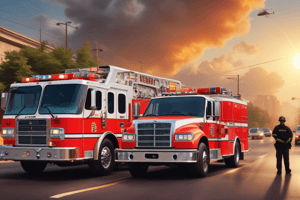Podcast
Questions and Answers
Who are considered first responders?
Who are considered first responders?
- Patrol officers
- Firefighters
- Emergency medical personnel
- All of the above (correct)
Who is usually first to arrive on scene?
Who is usually first to arrive on scene?
First responders
What is the primary duty assigned to an officer?
What is the primary duty assigned to an officer?
Preservation of life
First responders can dictate the success or failure of investigative officers.
First responders can dictate the success or failure of investigative officers.
After preservation of life, what is a major duty of first responders?
After preservation of life, what is a major duty of first responders?
What must a first responder do before entering a scene?
What must a first responder do before entering a scene?
An officer is automatically in the department's jurisdiction if he was dispatched to an area.
An officer is automatically in the department's jurisdiction if he was dispatched to an area.
What is the mission when approaching a scene?
What is the mission when approaching a scene?
The duties of the first responder are the same at every type of crime scene.
The duties of the first responder are the same at every type of crime scene.
What are the primary actions of a first responder upon arrival?
What are the primary actions of a first responder upon arrival?
How should officers arrive to the first responder?
How should officers arrive to the first responder?
Define mechanical loss.
Define mechanical loss.
Mechanical loss is an acceptable loss of evidence.
Mechanical loss is an acceptable loss of evidence.
What should officers point out to medical personnel at the scene?
What should officers point out to medical personnel at the scene?
How long must the scene be protected?
How long must the scene be protected?
What must the first officer on the scene attempt to do?
What must the first officer on the scene attempt to do?
Define perimeter.
Define perimeter.
What should be done once the boundaries have been identified?
What should be done once the boundaries have been identified?
What is the most common way to set up a perimeter?
What is the most common way to set up a perimeter?
What does a defined physical perimeter ensure?
What does a defined physical perimeter ensure?
It is better to over-define an area rather than underestimate.
It is better to over-define an area rather than underestimate.
What is the most effective for ensuring integrity?
What is the most effective for ensuring integrity?
What are the three levels of containment?
What are the three levels of containment?
Define the outer perimeter.
Define the outer perimeter.
Define the inside of the outer perimeter, adjacent to the actual crime scene.
Define the inside of the outer perimeter, adjacent to the actual crime scene.
What level of containment holds the command post?
What level of containment holds the command post?
Define command post.
Define command post.
Define the perimeter that defines the specific crime scene target area.
Define the perimeter that defines the specific crime scene target area.
Other officers, superiors, or government officials should be allowed access to the crime scene.
Other officers, superiors, or government officials should be allowed access to the crime scene.
Every person that enters the crime scene is a potential destroyer of physical evidence, even if it is unintentional.
Every person that enters the crime scene is a potential destroyer of physical evidence, even if it is unintentional.
Define Locard's exchange principle.
Define Locard's exchange principle.
Flashcards are hidden until you start studying
Study Notes
First Responders Overview
- First responders include patrol officers, firefighters, and emergency medical personnel.
- Their primary duty is the preservation of life during emergencies.
Scene Arrival and Responsibilities
- First responders are typically the first to arrive on the scene of an incident.
- Before entering a scene, responders must ensure they have the legal right to do so.
- Upon arrival, they must maximize safety, remain observant for evidence, and guide EMS to the injured.
- Officers should use indirect pathways to reduce scene contamination.
Crime Scene Management
- A key responsibility is to secure and preserve the crime scene and evidence.
- The concept of "mechanical loss" refers to the loss of evidence due to life-saving efforts.
- Evidence must be protected until all physical evidence is documented and collected.
- The first officer on the scene must attempt to "freeze" the scene by removing witnesses and suspects.
Perimeter Establishment
- The outer perimeter is the physical boundary of the crime scene.
- Upon identifying boundaries, a perimeter should be established to distinguish what is and is not a crime scene.
- The most common method for setting up a perimeter is using crime scene barrier tape.
- Over-defining an area is preferred to ensure clarity in crime scene delineation.
Levels of Containment
- Multi-level containment is the most effective method for ensuring crime scene integrity.
- Three levels of containment exist:
- The outer perimeter, which accommodates medical personnel.
- The second level, which includes the area for police and emergency personnel.
- The innermost perimeter, which defines access to the specific crime scene target area.
Command Post and Control
- The command post, or "incident command," coordinates on-scene activities.
- Only individuals actively involved in processing the scene should enter the strictest perimeter; unauthorized access compromises evidence integrity.
- Every person entering the crime scene poses a potential risk to evidence, even unintentionally.
Additional Concepts
- Locard's exchange principle posits that trace evidence is always found at a crime scene and on every individual present.
Studying That Suits You
Use AI to generate personalized quizzes and flashcards to suit your learning preferences.



